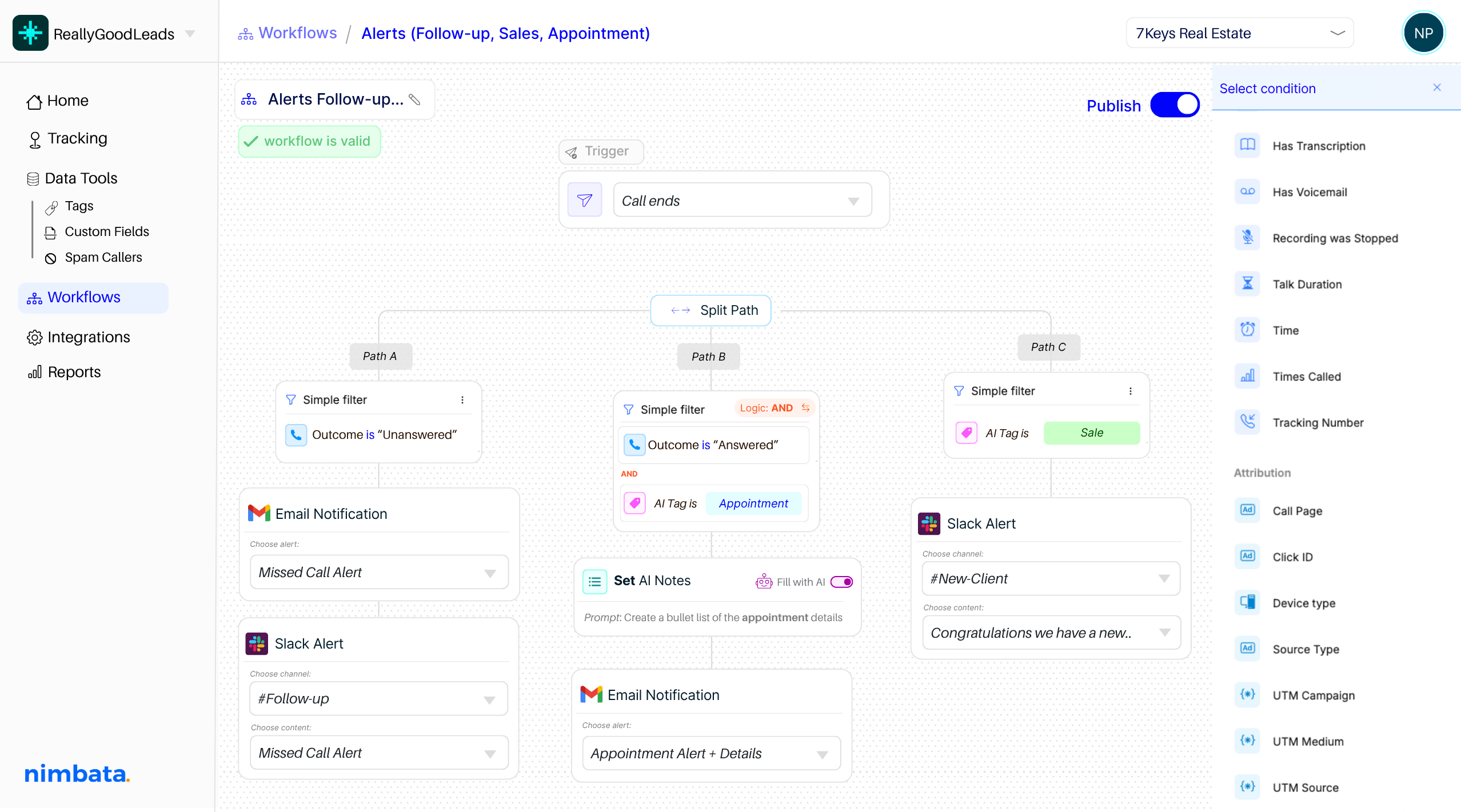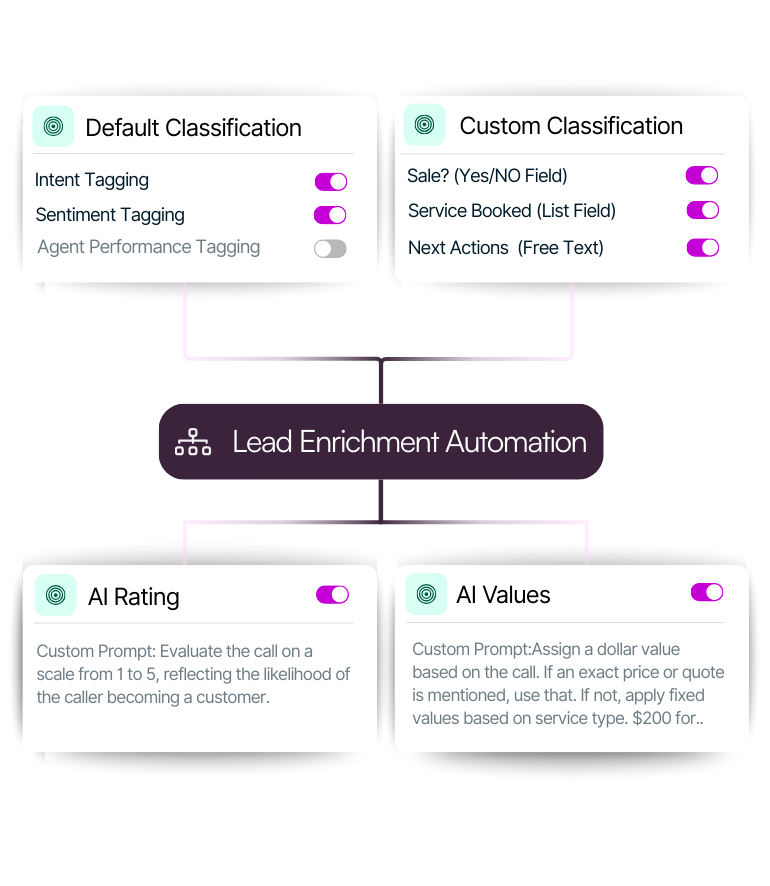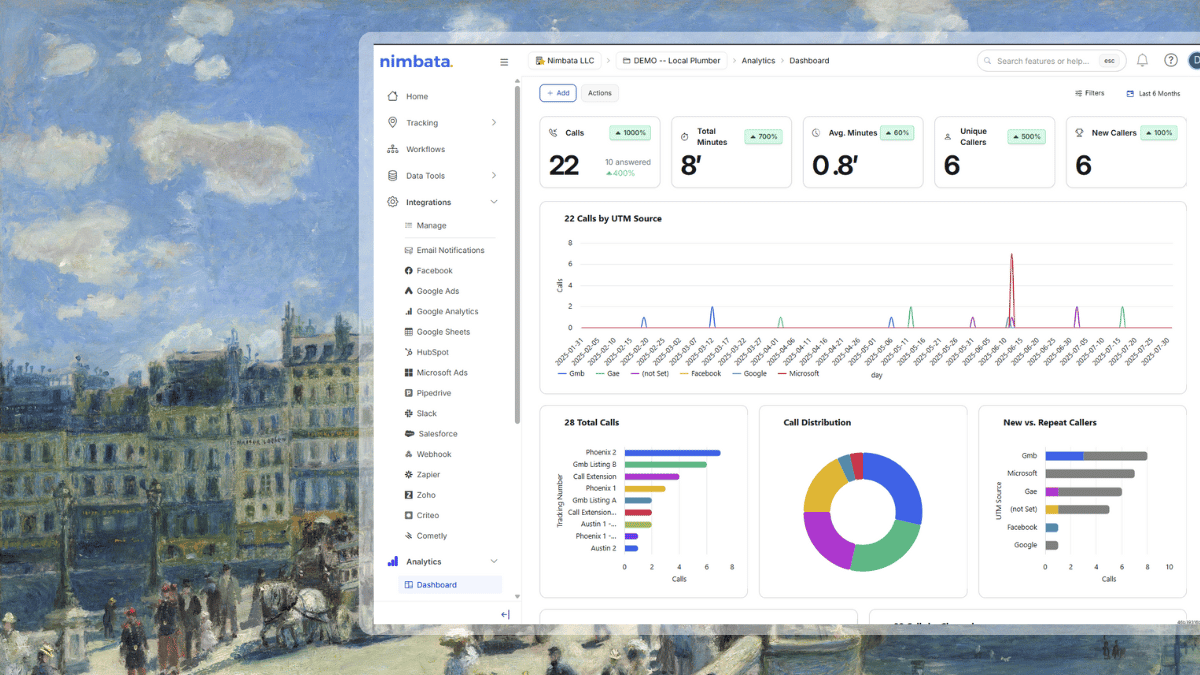In lead generation, everyone knows the truth: no two leads are built the same.
Some are red-hot buyers. Others are just… someone’s 2012 dusty contact.
Yet, thousands of businesses still cling to dusty CRMs and outdated phone logs… just in case.
Meanwhile, today’s marketers are expected to be part strategist, part detective. You need to know who called, how they found you, when they engaged and most importantly why they called. That’s the key to knowing what’s actually working.
That’s the insight that powers better decisions and smarter optimization.
Traditional call tracking tells you the who, how, and when.
AI call tracking unlocks the why and tells you what to do about it.
In this guide, we’re breaking down:
➕How AI call tracking works
➕ What makes it radically different from the “set-it-and-forget-it” dashboards of the past
➕ And how to actually use ai call tracking to boost your marketing ROI
We’ll cover real-world use cases, deeper analytics strategies, tools worth exploring, and a few spicy truths about what matters (and what doesn’t).
Let’s decode the calls.
What is AI Call Tracking?
AI call tracking is an evolution of traditional call tracking. It still shows you who called, when, and from which source but it goes several layers deeper by analyzing the actual content of the conversation.
At its simplest, AI uses machine learning to understand and analyze calls and extract meaning, context, outcomes or anything else you need. That could be identifying whether a lead was qualified, tagging common questions or objections, detecting intent, or even generating a summary of what was discussed.
Instead of just capturing metadata (call duration, caller ID, source), AI call tracking captures context:
- What was the purpose of the call?
- Was the caller a lead, a support request, or just noise?
- Was there buying intent or an actual purchase or appointment?
- What was the real dollar value of the call?
It removes the need for manual tagging or call reviews and helps teams understand the why behind calls at scale.
For marketers, this means:
- You know which campaigns brought in high-quality leads
- You can tie revenue or intent back to specific channels
- You stop measuring performance by call volume and start tracking outcomes
(And yes, we’ll dig deeper into all of that in the next sections.)
This kind of AI call analysis removes the need for manual review or tagging. It gives marketers the ability to measure campaign performance not just by volume, but by outcome and lead quality.
In short, AI call tracking helps businesses understand what’s happening in phone conversations at scale so they can make better marketing decisions, attribute revenue accurately, and optimize campaigns based on real conversation data.
AI Call Tracking vs traditional: what marketers actually get
It’s not about more data it’s about the right data. Traditional call tracking tells you which campaigns generated calls. AI call tracking tells you which ones actually drove results.
Here’s a breakdown of the real marketing value:
| Marketing Outcome | Traditional Call Tracking | AI Call Tracking |
| Tracks source (campaign, keyword, channel) | ✅ | ✅ |
| Understands why the lead called | ❌ | ✅ |
| Automatically qualifies leads | ❌ | ✅ |
| Measures ROI based on call outcomes (not just volume) | ❌ | ✅ |
| Ties calls to revenue or pipeline impact | ❌ | ✅ |
| Identifies top-performing channels by value | ⚠️ (volume only) | ✅ |
| Optimizes campaigns based on lead quality | ❌ | ✅ |
| AI-generated call summaries & notes | ❌ | ✅ |
| Real-time insights at scale | ❌ | ✅ |
| Manual tagging or call review required | ✅ | ❌ |
How to use AI Call Tracking: 6 most common uses that marketers are obsessed with
AI call tracking has become a core tool in the modern marketing stack not because it adds more data, but because it delivers the kind of insights marketers actually need: intent, outcomes, quality, and value.
Here are six high-impact ways marketers are putting AI call tracking to work every day:
1. Outcome-based attribution
Rather than measuring campaign performance by the number of calls alone, AI can identify the outcome of each call whether it was a sales inquiry, support request, appointment, or non-qualified lead. This allows marketing teams to assess which campaigns lead to meaningful interactions, not just activity.
2. Custom insight collection
Marketers can define specific business-relevant criteria such as intent to purchase, mention of a specific service, or competitor references and use AI to automatically detect and tag these events across all calls. This creates a consistent way to extract structured insights, aligned with business goals.
3. Lead scoring and qualification at scale
AI can evaluate caller intent and interaction context to score leads automatically. This helps segment high-intent leads from low-priority inquiries, which supports both campaign refinement and sales enablement.
4. Channel and keyword ROI analysis
When AI links call outcomes to source-level data (like channel or keyword), marketers can assess not only which sources generate calls but which ones contribute to business results. This supports more accurate budget allocation and optimization decisions.
5. Sentiment and language pattern analysis
AI can analyze tone, language, and conversational patterns to detect caller sentiment. Marketers can use this data to understand customer behavior trends, refine messaging, or identify recurring objections that may point to positioning or experience issues.
6. Structured data for reporting
By turning unstructured conversations into standardized fields such as call summary, call type, lead intent, or outcome AI call tracking enables marketers to generate clean reports without manual review. These insights can be used for performance dashboards, campaign analysis, or strategy reviews.
How to track deeper marketing insights with AI Call Tracking
Throughout this article, we’ve touched on automation in passing.
When AI detects X, you trigger Y.
That pattern sits at the core of how modern marketers operationalize insights. And when it comes to AI call tracking, automation isn’t just a feature it’s how analysis becomes action.
By pairing AI-driven call intelligence with automated workflows, you can go beyond passive reporting and start shaping outcomes: segment leads, push conversation, send call data to different tools, update CRMs, or notify teams.
In short, it’s how you turn raw first-party data into responsive, real-time marketing infrastructure.
Here’s how that works in practice.
Step 1. Automate call enrichment with outcomes and lead value
One of the most valuable aspects of AI call tracking is the ability to detect and classify call outcomes automatically. Instead of reviewing each call manually, AI can determine whether the caller expressed interest, booked an appointment, made a purchase, or simply asked a question.
To support more specific business needs, teams can define their own custom fields and prompt the AI to capture relevant details—such as product names, service types, intent, or objections. Sentiment analysis can also be applied to detect the emotional tone of the caller, helping distinguish between positive, neutral, and negative experiences.

Step 2. Improving reporting and ROI calculation in Google Ads & GA4
Once outcomes and values are captured, this data can be sent to platforms like Google Ads and Google Analytics. This enables marketers to go beyond “one-size-fits-all” conversions and instead trigger different conversion types based on what actually happened on the call.

For example, one campaign might generate calls that consistently lead to bookings, while another might only drive low-intent inquiries. AI allows you to associate actual value with each call, giving you more accurate reporting on campaign ROI and performance.
🦸 Check out → How to train Google’s Algorithm using lead scoring importation for better quality leads
Step 3. Enriching CRM records with contextual data
AI-generated summaries and tags can be passed directly into your CRM, enriching each contact record with structured context without requiring manual entry. This includes auto-creating new contacts, updating custom properties (such as product interest or lead type), and logging key call outcomes.
What makes this particularly useful is that the content and structure of the AI-generated notes can vary based on the nature of each call. For example:
- If the sentiment is negative, the AI can generate a list of objections.
- If the call includes a booking, it can highlight appointment details.
- For sales calls, it might summarize key decision factors or the service discussed.
Using prompt settings, teams can control not just the tone and length of the summary, but also the specific type of insight they want extracted per use case. This ensures the data passed into your CRM is not only accurate but relevant to the next team in the workflow.
Step 4. Using Alerts to support team collaboration
AI-generated call data can also be used to trigger alerts based on defined conditions. These alerts help teams respond quickly to specific events such as a new sales lead, a negative sentiment call, or a missed high-value inquiry.
Marketers can configure automated workflows that send alerts via email, Slack, or other channels based on outcomes, values, or tags. This creates alignment between marketing, sales, and account teams without needing to review every call manually.

4 AI Call Tracking Tools worth exploring & what to consider before purchasing
If you’re looking to get started or to upgrade from basic call tracking several platforms now offer AI-powered capabilities. But not all tools are built with the same focus, and it’s important to look beyond surface features.
Here are a few things to consider before choosing a platform:
- Focus: Many AI call tracking tools are designed for agent coaching or contact center operations, rather than marketing attribution or campaign optimization.
- Pricing: Some platforms offer AI as an add-on with additional usage-based fees, which can impact cost at scale.
- Flexibility: While some tools seem powerful at first glance, they may offer limited customization once you’re actually configuring prompts, reports, or CRM syncs.
Below are 4 platforms offering AI call tracking capabilities:
| Tool | AI Capabilities | Best For | Marketing Relevance | Key Considerations |
| CallRail | Call summaries, follow-up templates, transcription | SMBs, agencies using basic call tracking | Entry-level AI, good for surface insights | AI focused on agent scoring; limited flexibility |
| CallTrackingMetrics (askAI) | Custom tagging, scoring, keyword analysis | Hybrid sales/marketing teams | Allows flexible tracking of call outcomes and intent | AI is a paid add-on; cost scales with usage |
| Nimbata | Custom prompts, summaries, sentiment, value scoring, CRM sync | Marketing teams, agencies, performance marketers | Built specifically for outcome-based attribution, lead quality & reporting | High flexibility with tailored automation workflows |
| Invoca | Purchase intent detection, keyword groups, ad platform integration | Enterprise marketing teams, multi-location brands | Strong attribution and ad integrations at scale | Higher cost and setup complexity |
1. Callrail AI
CallRail offers a solid entry point into AI call tracking, especially for small to mid-sized businesses already using the platform for lead attribution. Its AI features include transcription, call summaries, and lead scoring based on detected phrases. However, the AI is primarily oriented toward evaluating agent performance and call quality, rather than marketing outcomes like revenue attribution or lead value.For marketers, it works well if you want lightweight call insights without deep customization. But if you’re looking to extract specific outcomes, automate workflows, or track call value at a campaign level, the tool may feel limited.
2. CallTrackingMetrics (askAI)
CallTrackingMetrics offers one of the more flexible AI setups through its askAI engine. You can configure custom tags, analyze intent, and score calls using criteria aligned to your funnel. This makes it a good fit for teams balancing both sales and marketing use cases.
That said, the AI layer is offered as an add-on, and costs can increase if you’re running large volumes. For marketing teams focused on clean attribution and first-party data enrichment, askAI offers solid tagging and outcome tracking but may require careful configuration to avoid bloat.
3. Invoca
Invoca is an enterprise-grade platform built for teams managing high call volumes across multiple locations or brands. Its AI capabilities include purchase intent detection, keyword groups, and automated quality scoring. The tool integrates deeply with ad tech platforms like Google Ads and Meta, enabling revenue attribution at scale.
That said, Invoca comes with a higher cost and learning curve, and is best suited for organizations with complex structures and technical support. For advanced attribution modeling and call intelligence at scale, it’s a strong contender but likely more than what smaller teams need.
3. Nimbata
Nimbata takes a marketing-first approach to AI call tracking. Instead of focusing on agent behavior, it emphasizes call outcomes, lead quality, and value-based attribution. Users can define custom prompts for call summaries, tags, and field values allowing the AI to extract exactly what’s relevant to your campaigns.
You can also segment sentiment, automate alerts, sync enriched data into CRMs, and send conversion values to ad platforms. For performance-focused teams that want flexibility, marketing attribution, and actionable call data, Nimbata stands out, especially if you’re looking to operationalize insights across channels.
Final thoughts
Phone calls are no longer a black box. With AI call tracking, marketers finally have the tools to analyze conversations with the same precision they apply to clicks, sessions, and form fills.
But this isn’t just about better data. It’s about putting that data to work whether it’s qualifying leads automatically, sending real value back to ad platforms, enriching CRM records, or triggering workflows based on actual outcomes.
The marketers winning today aren’t just tracking calls. They’re using AI to understand them, segment them, and act on them all at scale.
If you’re still treating call data as an afterthought, now’s the time to make it part of your core strategy.




